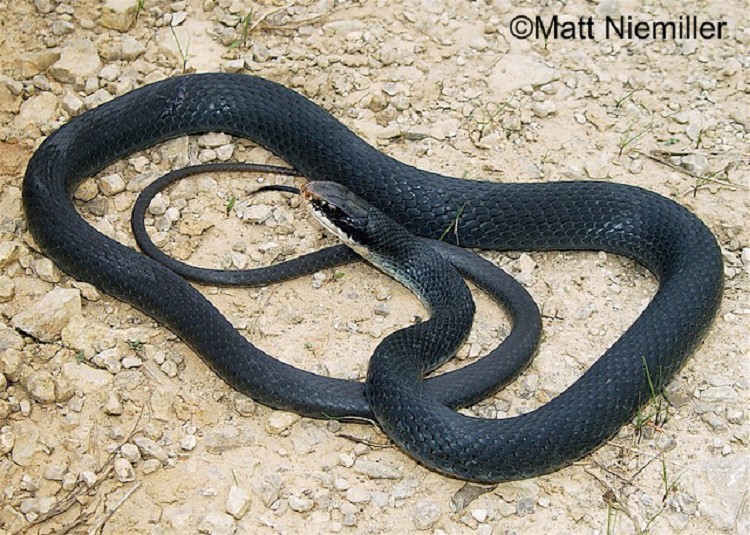North American Racer, Coluber constrictor
Two subspecies are recognized in Tennessee: Northern Black Racer (C. c. constrictor) and Southern Black Racer (C. c. priapus).
The Northern Black Racer occurs in the eastern half of the state and the Southern Black Racer occurs in the western half.
Description: A large, slender, solid black snake (36.0 to 60.0 inches in length) with smooth and shiny scales.
Throat and chin have some white, and eye color (iris) is brown or dark amber.
The belly is dark gray to dark blue in color. Males are slightly larger than females.
Young are lighter in color with dark gray, brown, or reddish-brown pattern on the back.
Northern and Southern Black Racers can only be distinguished by internal anatomical differences.
Similar Species: Gray Ratsnake has keeled scales and the body has a loaf of bread shape; young Gray Ratsnakes have distinct, dark blotches on the tail.
Eastern Coachwhip (black variant) is distinctly lighter or reddish towards the rear of the body. Melanistic specimens of Eastern Gartersnake have keeled scales.
Habitat: Found in a variety of habitats, but prefers open areas such as old fields, agricultural fields, pastures, and forest edges.
Diet: A variety, including insects, frogs, birds, other snakes, small rodents, and bird eggs.
Breeding information: Adults breed in spring. Females deposit 4-36 oblong eggs, which have small salt-like bumps on the shell, in moist underground sites, such as under logs or rocks. Eggs hatch in late summer or fall.
Status in Tennessee: Common in suitable habitat; fairly resilient to human activities.
Fun Facts:
- Racers are named for their incredible speed in escaping from predators.
- Black racers use a distinctive hunting strategy known as periscoping, in which they lift the upper part of their body to search for prey.
Best places to see in Tennessee: Any open field habitat, especially near edges.
